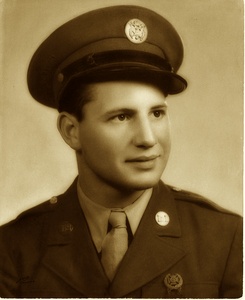 Lawrence A. Roberts - Camp White, Oregon - "A" Company - 299th Combat Engineer BattalionBorn: February 7th, 1924, in Inman (Loon Lake), Franklin County, New York.
Lawrence A. Roberts - Camp White, Oregon - "A" Company - 299th Combat Engineer BattalionBorn: February 7th, 1924, in Inman (Loon Lake), Franklin County, New York.
Died: June 6th, 1944, in D-Day invasion of Normandy France on Omaha Beach - "A" Company of the 299th Combat Engineer Battalion. First Wave to hit the beaches of Normandy. He is resting peacefully with his comrades at the Normandy American Cemetery (Photo Below).
Married: No
Children: None
Private Lawrence Roberts was a World War II veteran; he was killed in action.
Sibling to Francis Roberts and Paul Roberts
Adirondack Daily Enterprise, June 4, 2005
You Know What... ?
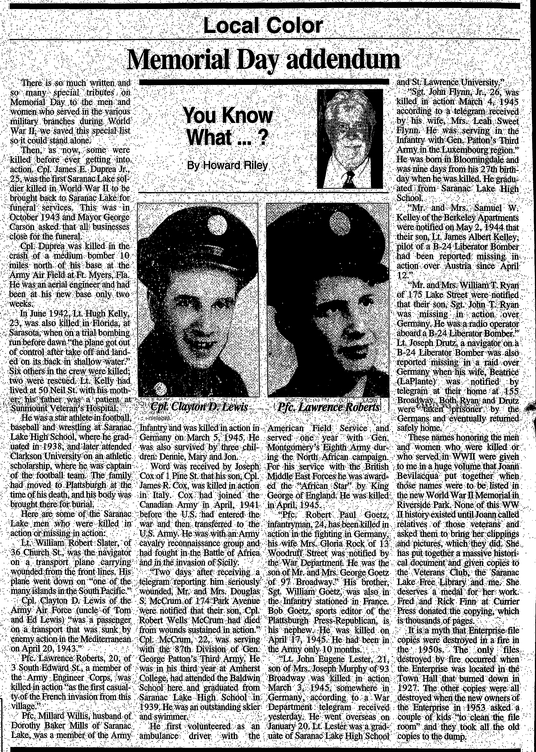 Adirondack Daily Enterprise, June 4, 2005
Adirondack Daily Enterprise, June 4, 2005
By Howard Riley
…Pfc. Lawrence Roberts, 20, of 3 South Edward Street, a member of the Army Engineer Corps, was killed in action "as the first casualty of the French invasion from this village."
Photos of PFC Lawrence A Roberts provided by Dale and Alan Roberts

 Normandy American Cemetery
Normandy American Cemetery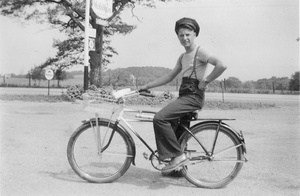 Lawrence before the war in Auburn, NY
Lawrence before the war in Auburn, NY
Further Information on Lawrence A. Roberts and the D-Day Invasion - Contributed by Alan D. Roberts
Lawrence, one of twelve children, was born in Loon Lake, New York in 1924 and the Roberts family relocated to Saranac Lake sometime after 1930. Many of his older siblings had grown up, married, started families, and relocated to the Auburn, New York - Finger Lakes region. Lawrence moved to this area in the early 1940s and was staying with his sister's family and attended Port Byron High School and then worked in the defense industry in Auburn. He was inducted into the service in Auburn and was placed in the 299th Combat Engineer Battalion with many other young soldiers from the Auburn to Buffalo, New York region.
In 1994 for the 50th Anniversary of a D-Day a plaque honoring Lawrence and five others who gave the ultimate sacrifice for our country that day from the 299th, was dedicated at the Cayuga County Courthouse in Auburn NY. A reunion was held of the 299th Combat Engineer Battalion and my mother, Martile (Midge) Roberts, was an invited guest to represent the Roberts family at this event. She met many of the veterans who served with Lawrence on that historic day and they shared their experiences and recollections with her. I should have written down or somehow recorded some of this information she received as not long after this reunion my mother passed away.
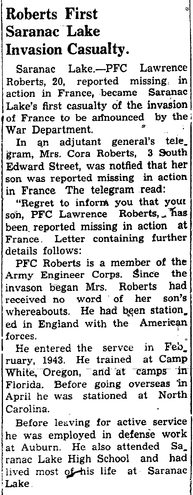 Chateaugay Record News Report - July 7, 1944
Chateaugay Record News Report - July 7, 1944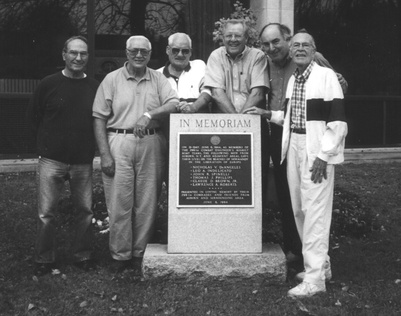 299th Combat Engineer Battalion Veterans at Memorial in Auburn, NY From left: Sam Trinca, Chet DePalma, Tony DeTomaso, Jim Burke, and Chuck Hurlbut.
299th Combat Engineer Battalion Veterans at Memorial in Auburn, NY From left: Sam Trinca, Chet DePalma, Tony DeTomaso, Jim Burke, and Chuck Hurlbut.
In 2009 I found a web site for the 299th Combat Engineer Battalion and made an inquiry to the web administrator as to whether any of the members had any recollections of my uncle and the events of D-Day. I received a response from Mr. Michael Accordino who was in the same platoon and landing craft as Lawrence. I appreciate his response as he passed away on June 19th 2012. His response to me was as follows:
March 13, 2009
Dear Alan,
Lawrence was in A Company and in my platoon. His job on landing was to destroy the obstacles that were at the waters edge. The team consisted of 5 Army and 7or 8 Navy men. The army men,all from A Company were Bill Scanlon, Carl Davies, Kenneth Fatty, Lawrence Roberts, all KIAs and Dominic Debenedetto. Dom was wounded is from Auburn, NY and is involved in the ceremonies (Note: 299th Reunions). I was in the same assault boat #12,with this group. The rest of the men, about 20, moved away from the water's edge to other obstacles on the beach. I believe they layed their charges on the obstacles and they went off prematurely. Four or five Navy men were killed and a few wounded. I remember your Uncle, but can't tell to much about him. All this happened 65 years ago this June. I may have a picture of your Uncle and an A Company group picture taken in Ft.Pierce,FL. I winter in Florida and will be able to search for them when I return to Buffalo in May. My wife and I plan to be in Auburn this June.
Sincerely, Michael Accordino
The Following is a more detailed recollection of these events written by Mr. Accordino and found on the 299th Combat Engineer Battalion site.
WWII - "First On Omaha / D-Day "
By Michael Accordino (January 29th 1924 - June 19th 2012)
I went across the English Channel on an LCT ( Landing Craft tank ) that towed an LCM, ( Landing Craft Mechanized ). On the LCT was our demolition team assault team #12. There also was three or four tanks aboard and their crews. It was a rough crossing but I suffered no seasickness. The LCM was carrying our supplies, demolition, prima cord, fuses etc. The LCM also carried a seven-man rubber boat with all the supplies in the rubber boat. Now this was a problem for us. We never trained for this situation. Which was for us to drag this rubber boat off the LCM with all the supplies in it. The thing must have weighed 700 pounds. When we arrived to an area 2,000 plus yards away from the Omaha Beach, the LCM came along side and we jumped into it from the LCT. I must add here that our outfit, the 299th Engineer (c) Battalion, was the only US Army Unit that landed on both American Beaches, Omaha and Utah. A and C company landed on Omaha Beach, B Company on Utah. I was in A Company. You probably noted that Gene Shales was in B Company and landed on Utah Beach. The LCM circled about until the other assault boats from our outfit joined us and then we headed for Omaha Beach. There were eight, numbered ( 9 to 16 ) and four lettered assault boats ( E to H ). Our destination was the sector named "Easy Red". It turned out to be red but it wasn't easy.
On the way to the Beach soldiers were standing on a tank and waving and yelling frantically. The helmsman steered the LCM to them and asked them what the problem was. They were sinking. The helmsman said he couldn't help them and he continued to the beach. He should not have done that. His job was to get us to the beach. There were rescue people out there to take care of that matter. Now there were 28 to 30 tanks that went into the water and "swim to the beach". These were DD Tanks ( Duel Drive ) fitted with a canvas device that was to keep the water out. The Channel was rough and they took in water. Only two of those tanks made it in, the rest sank losing the crews in most cases. The ones that made it to the beach were knocked out immediately. In fact I didn't see any operative tank on the beach the whole day. Going into the beach we watched in fascination as shells from the Battle Ship Texas and rockets from landing barges hitting the beach. What a sight. We cheered and I thought it was going to be an easy day. of course it wasn't.
As we were getting closer I strapped two packs of demolition on my body each totaling 20 pounds, back and front. German shells began bursting about us. When we got closer the ramp was lowered, but we had a job to do first. We had to get that rubber boat with all its supplies off the LCM. Now remember we never trained for this. We got a hold of that boat and heaved and hoed and it wouldn't budge. All this time the Germans were trying to put a shell in our boat. Some one yelled leave it and we did. The helmsman didn't like it but off we went. I was in the front of the boat along with another soldier. We were the first off that boat. When I jumped and landed in the water and went under. The front pack hit my Life Belt setting off a charge that inflated it I was able to get my feet to the bottom to head to the beach. When I came up the soldier that jumped off with me was alongside me and he was crying. I asked "what's the matter?" I soon found out. Machine gun bullets were landing all around us. I moved through the water to the shoreline there was no other way to go, unless I wanted to swim back to England. When I reached the shore I laid down to remove the demolition packs from my body.. I then heard a voice behind me asking if I was ok. It was Billy Scanlon Who was from my hometown, Buffalo, NY. Part of our team was made up of strong swimmers who were to blow up the water obstacles and the rest of us were to blow up the obstacles further up the beach. I noticed that his men were crowded around him and I knew that was a bad situation because they would draw fire. I got out of there and moved away from them. That group was made up of both Army and Navy men. That group lost KIA 4 army (Bill Scanlon, Carl Davies, Kenneth Fatty, and Lawrence Roberts) and 6 Navy men and a few wounded. What we think happened is that they set their charges on a number of obstacles and they went off prematurely. Billy was killed and is buried in Kenmore, NY.
I got to an obstacle and laid my charges on it to blow. Our prima could hook up to it and blow the demolition off all at once. His name, Bill McCue, was walking upright unwinding a spool of prima cord. I yelled to him to get down, but all he did was say the word that won the war and kept on going. He never got as much as a scratch. I tied my charges to the prima cord and then moved to the dune line. As I was front of me. I thought this guy is going to raise his sights and get me. What I did is turn around back to an obstacle I passed and got behind it. While lying there three soldiers, with a large spool of wire, I think they were signal corp came alongside me to my right about 10 yards away. In the distance I could see one of our dozers that was to help clear the obstacles being hampered by infantrymen hiding behind it for protection. Jerry Burt, our squad leader was trying to direct it and chase away the infantrymen but they wouldn't move. The operator had to abandon it after it received a hit. I asked the soldiers, with the spool, what they were doing there? They couldn't answer me a mortar got them. All that time on the beach I was a loner, I wanted no one near me. The only one that got close to me was Bill McCue, the prima cord man. I decided to get out of there and advanced to the dune Line that afforded some protection. There I found some of my Buddies, some wounded and some shell shocked. Some of the wounded were brought to the Dune Line. In most battles and actions wounded are normally brought to the rear but in an invasion the only place and the safest place is toward the enemy. We laid on that Dune Line for a couple of hours and then moved up the slope and dug in. The spot were I dug in is below where the American Cemetery is located. We sat there the rest of the day and watched as the infantry and other troops tried to land.
One ship received a direct hit and saw men draped over the railings. It was a sad thing to see. That evening there was a false gas alarm. Some men were crying for gas masks. They got rid of theirs when they hit the beach. Not this guy. I had everything that I needed, except the most important, my rifle. I left it on the bottom when I went under. I had a rosary and prayed and prayed. That night before falling off to sleep "Bed Check Charlie" flew overhead taking pictures for the Germans, as he did every night during the war. A blanket of ack ack filled the sky trying to hit him. That is how my D-Day ended. I will never forget that day. Close to 70 men in the 299th were killed within minutes of landing and many wounded. Twenty-four are buried in the Normandy Cemetery and five are on the wall of the missing. Most of the KIAs were returned, as requested by their families and interred in their hometowns, there are others buried overseas in Belgium and France from other actions. eg: the "Battle of the Bulge" and Remagen Bridge. They are men I will never forget, "We were Family".
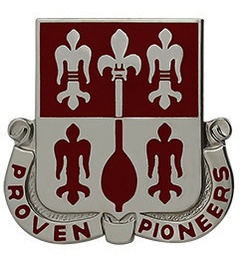 299th Combat Engineer Battalion Crest
299th Combat Engineer Battalion Crest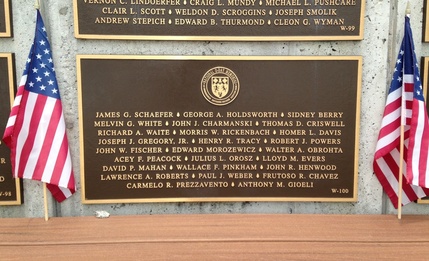 National D-Day Memorial Necrology Wall - Bedford VA - Lawrence A. Roberts
National D-Day Memorial Necrology Wall - Bedford VA - Lawrence A. Roberts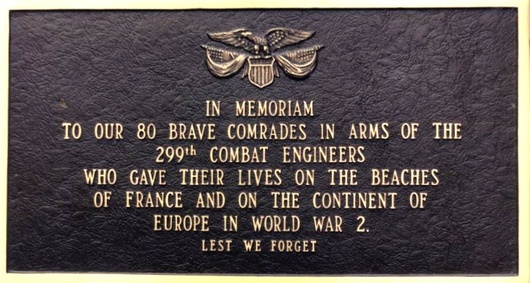
Comments




